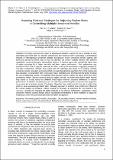| dc.contributor.author | Maere, Pierre C. P. | |
| dc.contributor.author | Clare, Andrew S. | |
| dc.date.accessioned | 2011-10-13T16:07:00Z | |
| dc.date.available | 2011-10-13T16:07:00Z | |
| dc.date.issued | 2010-08 | |
| dc.identifier.uri | http://hdl.handle.net/1721.1/66241 | |
| dc.description | url is for conference abstract. | en_US |
| dc.description.abstract | This study examined the impact of allowing an operator to adjust the rate of prompts to view automation-generated plans on operator performance and workload when supervising a decentralized network of heterogeneous unmanned vehicles. Background: Future unmanned vehicles systems will invert the operator-to-vehicle ratio so that one operator can control multiple vehicles with different capabilities, connected through a decentralized network. A previous experiment showed that higher rates of replan prompting led to higher workload and lower system performance. Poor performance was associated with a lack of operator consensus for when to accept the automation’s suggested prompts for new plan consideration. Method: Three initial rates of replanning were tested on an existing, multiple unmanned vehicle simulation environment that leverages decentralized algorithms for vehicle routing and task allocation, in conjunction with human supervision. Operators were provided with the ability to adjust the rate of replanning. Results: The majority of the operators chose to adjust the rate at which they were prompted to replan. Operators favored particular replan intervals, no matter which initial replan interval they started at. It was found that different initial replan intervals produced differences in mission performance. In addition, increasing amounts of replanning caused the system to destroy more targets but do a poorer job at tracking targets. Conclusion: Operators have preferences for the rate at which they prefer to view automation-generated plans. Allowing operators to institute these preferences influenced the overall mission performance. Further research is necessary to determine the full impact of the operators’ strategies for changing the replan intervals on net mission performance. Application: Future unmanned vehicles systems designs should incorporate the flexibility to allow operators to adjust the frequency at which the automation generates new plans for approval. | en_US |
| dc.description.sponsorship | Aurora Flight Sciences Corp. | en_US |
| dc.description.sponsorship | United States. Office of Naval Research | en_US |
| dc.language.iso | en_US | |
| dc.publisher | International Federation of Automatic Control | en_US |
| dc.relation.isversionof | http://www.univ-valenciennes.fr/IFACHMS2010/abstact/13-A-Assessing_operator_strategies_for_adjusting_replan_alerts_in_controlling_multiple_unmanned_vehicles_-_Pierre_Cp_Maere.pdf | en_US |
| dc.rights | Creative Commons Attribution-Noncommercial-Share Alike 3.0 | en_US |
| dc.rights.uri | http://creativecommons.org/licenses/by-nc-sa/3.0/ | en_US |
| dc.source | MIT web domain | en_US |
| dc.title | Assessing Operator Strategies for Adjusting Replan Alerts in Controlling Multiple Unmanned Vehicles | en_US |
| dc.type | Article | en_US |
| dc.identifier.citation | Maere, P. C., Clare, A. S., Cummings, M. L., “Assessing Operator Strategies for Adjusting Replan Alerts in Controlling Multiple Unmanned Vehicles,” 11th IFAC/IFIP/IFORS/IEA Symposium on Analysis, Design, and Evaluation of Human- Machine Systems, Valenciennes, France, Aug. 2010. | en_US |
| dc.contributor.department | Massachusetts Institute of Technology. Department of Aeronautics and Astronautics | en_US |
| dc.contributor.approver | Cummings, M. L. | |
| dc.contributor.mitauthor | Cummings, M. L. | |
| dc.contributor.mitauthor | Clare, Andrew S. | |
| dc.relation.journal | Proceedings of the 11th IFAC/IFIP/IFORS/IEA Symposium on Analysis, Design, and Evaluation of Human-Machine Systems | en_US |
| dc.eprint.version | Author's final manuscript | en_US |
| dc.type.uri | http://purl.org/eprint/type/ConferencePaper | en_US |
| dspace.orderedauthors | Maere, Pierre C. P.; Clare, Andrew S.; Cummings, Mary L. | en_US |
| dspace.mitauthor.error | true | |
| mit.license | OPEN_ACCESS_POLICY | en_US |
| mit.metadata.status | Complete | |
